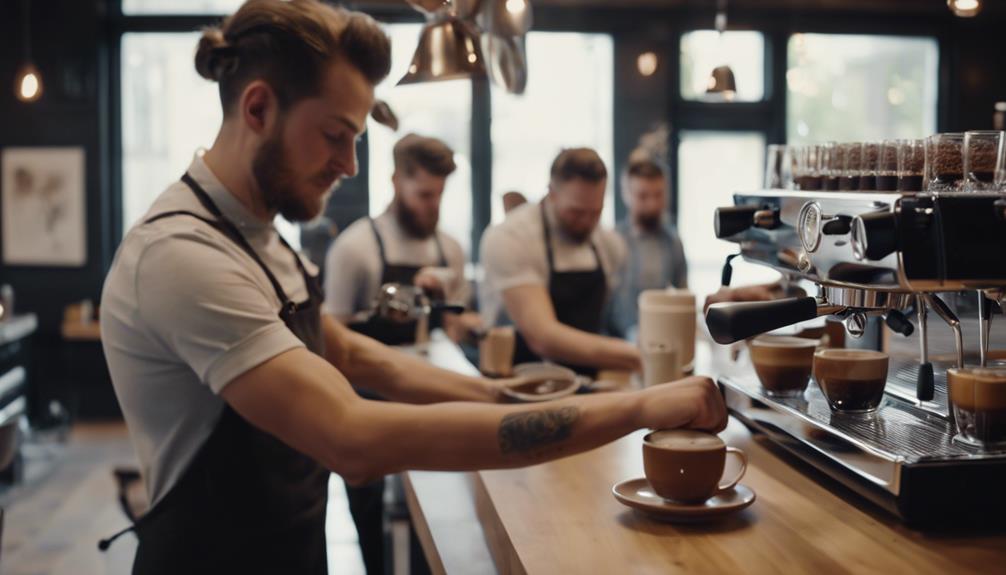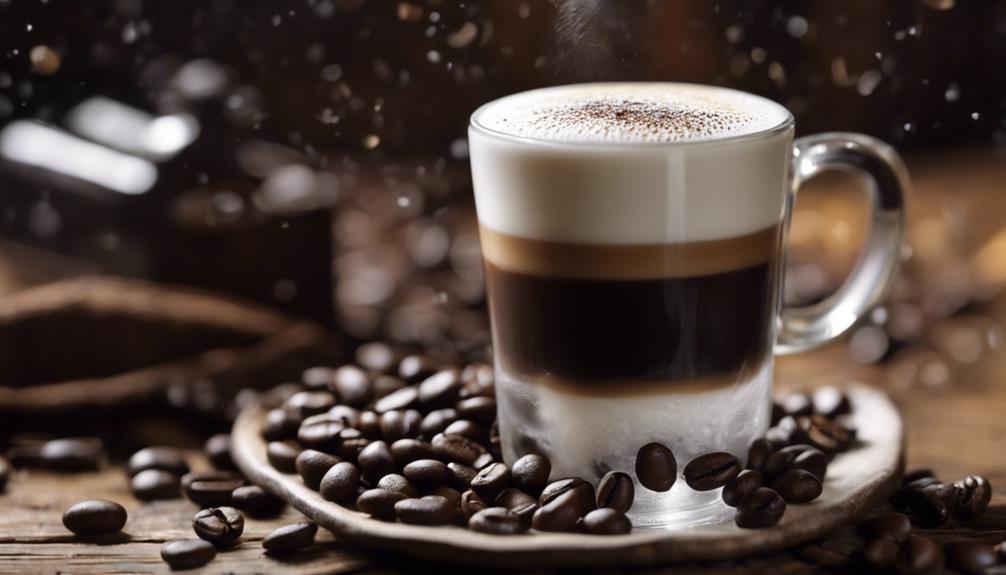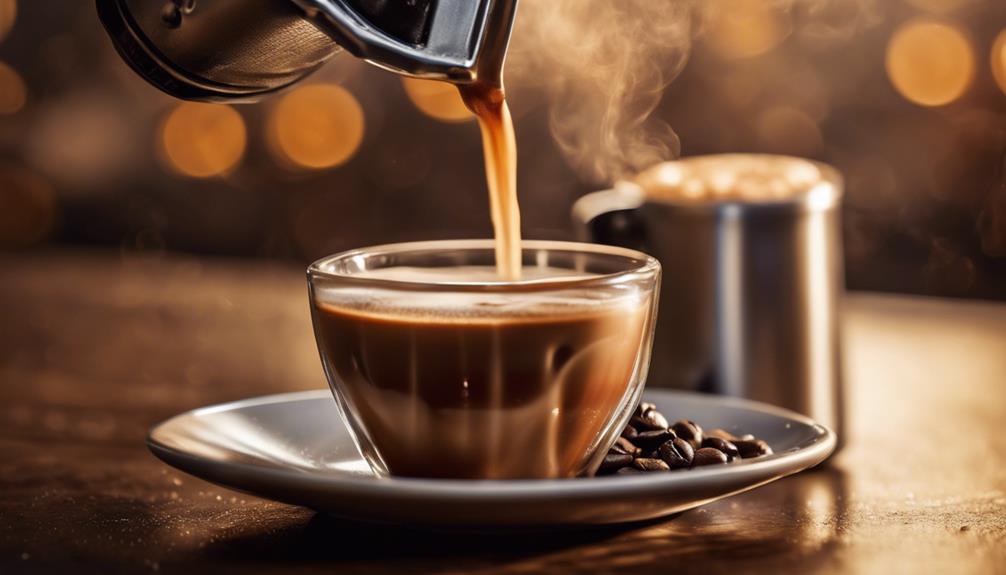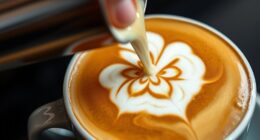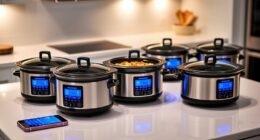You may think that brewed coffee is more powerful in terms of caffeine compared to espresso, but in reality, espresso has a higher caffeine concentration per ounce at an average of 63 milligrams per ounce, while brewed coffee typically has 12-16 milligrams per ounce. Although brewed coffee may contain more total caffeine due to its larger serving size, espresso’s intense flavor and quick consumption make it a rapid energy booster. Armed with this knowledge, you can now explore the intricacies of each type of coffee and find the perfect match for your caffeine requirements.
Key Takeaways
- Espresso has a higher caffeine concentration per ounce (57-63 mg) compared to brewed coffee (12-16 mg).
- Despite this, brewed coffee often has more total caffeine due to its larger serving size.
- The perceived strength of espresso is due to its rich, concentrated flavor from high-pressure extraction, not just its caffeine content.
- Factors like coffee bean type, roast level, and brewing method can influence caffeine levels and flavor profiles in both espresso and brewed coffee.
Understanding Caffeine Content
When you crack open a can of espresso or brew a fresh cup of coffee, you're probably wondering which one packs a stronger caffeine punch.
Let's explore the caffeine content of both to settle the debate. An ounce of espresso contains approximately 63 mg of caffeine, while an 8-ounce cup of brewed coffee typically has around 95 mg of caffeine.
At first glance, it seems like coffee has more caffeine, but that's not the whole story. When comparing caffeine content per ounce, espresso has a higher concentration with about 57 mg of caffeine per ounce, compared to brewed coffee's average of 14 mg per ounce.
This is because the brewing method for espresso involves forcing pressurized hot water through finely ground coffee beans, resulting in a more concentrated beverage.
On the other hand, brewed coffee extracts caffeine over a longer brewing time, resulting in a larger volume with a lower concentration.
Coffee Vs Espresso Comparison
Now that you've got a handle on the caffeine content of both espresso and coffee, let's compare these two popular coffee drinks regarding their overall characteristics and flavor profiles.
One major difference lies in their flavor profiles. Espresso's shorter brewing time and high-pressure extraction process result in a richer, more concentrated flavor. On the other hand, brewed coffee offers a wider range of flavors influenced by various brewing methods. Notably, both espresso and brewed coffee can be made from the same coffee beans; the distinction primarily lies in the brewing method, not the bean type itself.
Another key difference is the way you consume them. Brewed coffee is typically consumed in larger volumes, which can lead to a perception that it has more overall caffeine, despite espresso's higher caffeine concentration per ounce.
Ultimately, the choice between espresso and brewed coffee comes down to personal taste preferences and the type of coffee experience you're looking for.
Factors Affecting Caffeine Levels

You might be surprised to learn that several factors affect the caffeine levels in your coffee, and understanding these variables can help you customize your brew to your desired buzz.
From the type of coffee bean to the brewing method, each element plays a significant role in determining the caffeine concentration of your espresso shot or cup of coffee.
Here are 4 key factors that influence caffeine levels:
- Coffee bean type: Robusta beans contain approximately double the caffeine of Arabica beans.
- Roast level: Lighter roasts generally maintain more caffeine than darker roasts due to the longer roasting time reducing caffeine content slightly.
- Brewing method: Espresso typically has higher caffeine concentration per ounce due to its smaller serving size compared to drip coffee.
- Coffee-to-water ratio: This ratio plays an essential role in determining caffeine levels, as it influences the extraction process during brewing.
Unique Experiences of Both
As you explore the world of espresso and coffee, you'll notice that each beverage offers a distinct experience.
You'll get a quick energy boost from espresso, which is perfect for those busy mornings when you need a rapid pick-me-up.
On the other hand, coffee provides a gradual awakening experience, ideal for savoring and enjoying at a leisurely pace.
Gradual Awakening Experience
Coffee's gradual awakening experience unfolds with each slow, savory sip, releasing caffeine into your bloodstream at a steady pace. As you enjoy your morning cup, the caffeine is absorbed gradually, providing a sustained energy boost. This experience is unique to coffee and is perfect for those who want to ease into their day.
Here are some key aspects of coffee's gradual awakening experience:
- Steady caffeine release: Caffeine is absorbed slowly, providing a sustained energy boost.
- Extended energy boost: The caffeine in an 8-ounce cup of coffee can last for several hours.
- Leisurely sipping: Coffee is ideal for slow, relaxed sipping, allowing you to savor the flavor and aroma.
- Controlled caffeine intake: The slower intake of coffee allows for a more controlled caffeine experience.
In contrast, espresso provides a quick jolt of energy with a single shot. While both beverages have their unique benefits, coffee's gradual awakening experience is perfect for those who want to start their day with a gentle boost.
Quick Energy Boost
Espresso's concentrated caffeine content packs a punch, providing a quick energy boost that's perfect for busy moments when you need a rapid pick-me-up. With approximately 63 mg of caffeine in a 1-ounce shot, you'll feel the energizing effect almost instantly. This is especially true when you consider the smaller serving size of espresso, which leads to rapid consumption and an immediate energy lift.
In contrast, coffee's caffeine content is spread out over a larger serving size, resulting in a more gradual awakening experience. When you need a quick energy boost, a shot of espresso is the way to go. Its rapid brewing time of 20-30 seconds allows it to deliver a stronger flavor profile and instant energy compared to the several minutes required for brewed coffee.
Many consumers rely on espresso for a quick pick-me-up during busy moments, and it's easy to see why. Whether you're facing a long day at work or a grueling workout, espresso's quick energy boost is just what you need to get moving.
Caffeine Content in Espresso
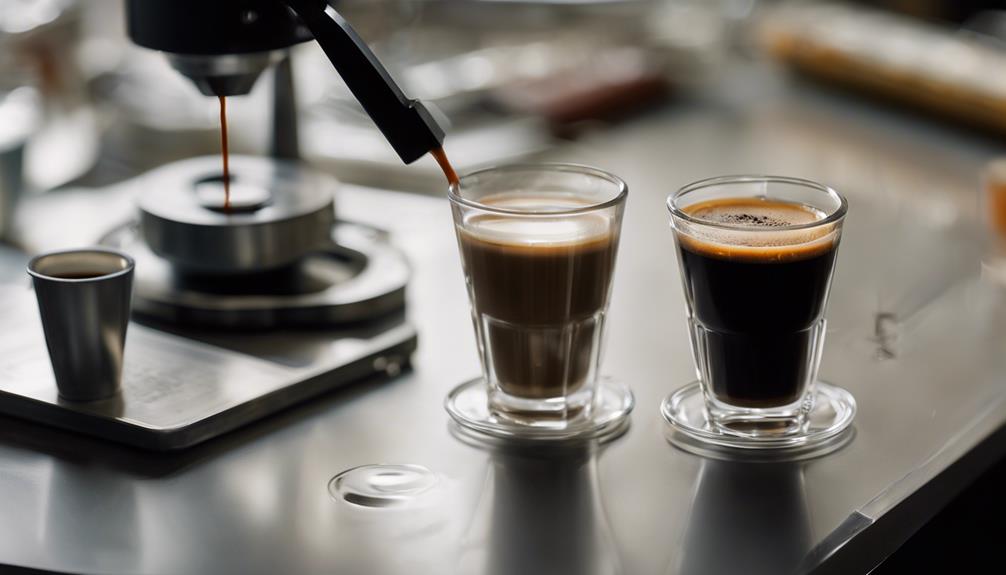
How much caffeine does a shot of espresso really pack? As a coffee lover, you might be surprised to know that a typical 1-ounce shot of espresso contains around 63 mg of caffeine. But that's not the whole story.
Here are some key facts to take into account:
- Caffeine per ounce: Espresso has a higher caffeine concentration than brewed coffee, with approximately 63 mg per 1 ounce.
- Espresso beans matter: The type of beans used can influence the caffeine level, with Robusta beans typically containing more caffeine than Arabica beans.
- Variability in brands: Even within espresso, the amount of caffeine can vary depending on the brand and serving size, such as Starbucks' 75 mg per 0.75 ounces.
- Total caffeine content: While espresso has a higher concentration, a standard serving of brewed coffee usually contains more total caffeine due to its larger volume.
When you take these factors into account, you'll realize that the amount of coffee you drink and the type of beans used can greatly impact your caffeine intake.
Whether you prefer a strong shot of espresso or a cup of brewed coffee, understanding the caffeine content can help you make informed choices as a coffee lover.
Debunking Common Misconceptions
You've probably heard that espresso is stronger than coffee, but is this claim based on fact or fiction? Let's debunk some common misconceptions. First of all, the strength of coffee is not determined by the type of beverage, but rather by the concentration of coffee grounds used. In fact, a typical serving size of espresso is only 1 ounce, while a standard cup of coffee is around 8 ounces. This means that while the caffeine content may be higher in a single shot of espresso, the overall caffeine intake from a regular cup of coffee is much higher. Additionally, the cost of espresso shot is often higher than a regular coffee due to the higher concentration of coffee grounds and the specialized equipment required to make it.
For starters, many think brewed coffee contains more caffeine than espresso, but the opposite is true. Espresso has a higher caffeine concentration per ounce, with about 63 mg in a 1-ounce shot compared to 12-16 mg per ounce in brewed coffee. While a larger serving of coffee might contain more caffeine overall, espresso packs a punch per serving size.
Another myth is that espresso beans are fundamentally different from coffee beans. Not true! Both can be made from the same types of coffee beans, and espresso is defined by its brewing method, not the beans themselves.
The brewing method is key, with espresso using high-pressure water to extract flavors and caffeine rapidly, while brewed coffee relies on a longer extraction time with boiling water. These misconceptions likely stem from espresso's concentrated flavor and smaller serving size, which can amplify its stimulating effects when consumed quickly.
Choosing the Right Brew for You
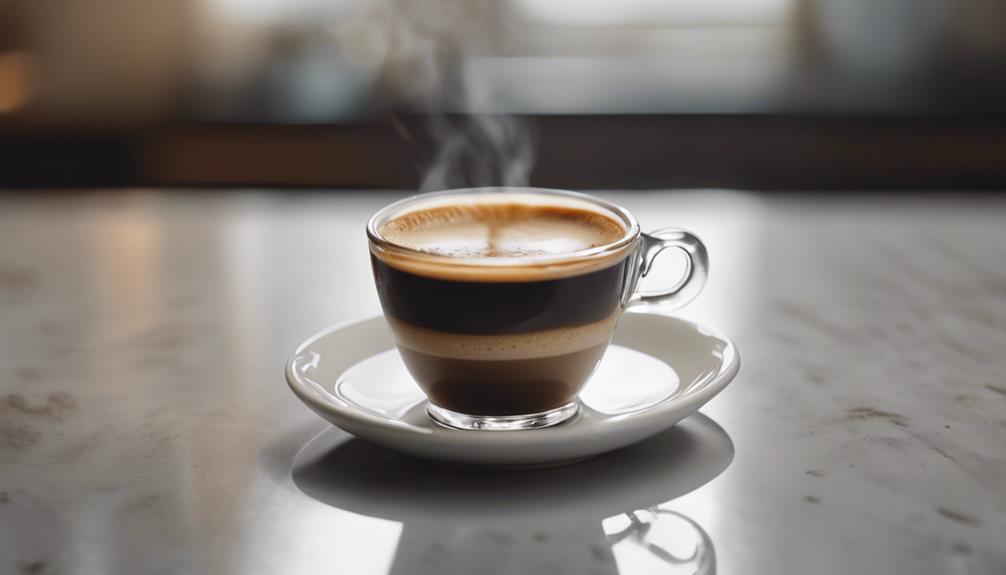
When it comes to choosing the right brew for you, you'll want to contemplate what matters most: do you prefer a strong, bold flavor or a smoother, more subtle taste?
Are you looking for a quick energy boost or a gradual pick-me-up?
Brewing Methods Compared
Your brewing method of choice can greatly impact the flavor and caffeine kick of your daily cup, so let's explore the differences between espresso and brewed coffee to find the perfect brew for you.
When it comes to brewing methods, there are some key differences to take into account:
- Extraction time: Espresso has a faster extraction time of 20-30 seconds, while brewed coffee takes around 4-6 minutes.
- Grind size: Espresso uses a fine grind, whereas brewed coffee typically uses a coarser grind.
- Caffeine concentration: Espresso has a higher caffeine concentration per ounce, averaging around 63 mg in a 1-ounce shot.
- Flavor profile: Espresso is known for its rich, concentrated taste, while brewed coffee offers a broader range of flavors based on the brewing method and time used.
Caffeine Content Analysis
Considering your daily caffeine needs, it's essential to understand the varying levels of caffeine in espresso and coffee to select the brew that best suits your taste preferences and desired energy boost.
When it comes to caffeine content, espresso packs a punch, with approximately 63 mg of caffeine per ounce, making it more concentrated than brewed coffee, which averages around 12-16 mg per ounce.
However, a standard 8-ounce cup of brewed coffee typically contains between 95 mg to 155 mg of caffeine, depending on the brewing method and coffee type. This means that while espresso has a higher caffeine concentration per ounce, a full serving of brewed coffee often results in a higher total caffeine intake due to its larger volume.
The caffeine content in both espresso and coffee can vary based on factors like the type of beans used, roast levels, and brewing techniques.
Flavor Profile Differences
Choosing between espresso and coffee ultimately comes down to your personal taste preferences, as the distinct flavor profiles of each brew cater to different palates and sensory experiences.
When it comes to flavor, espresso is known for its rich, concentrated taste, thanks to its shorter extraction time and high-pressure brewing method. On the other hand, brewed coffee offers a wider range of flavor profiles based on brewing methods and extraction times.
Here are some key differences to take into account:
- Richness and texture: Espresso's crema adds a unique richness and texture that brewed coffee lacks, unless you add toppings.
- Flavor complexity: Espresso's flavor complexity comes from the variety of beans used and the roasting process, often involving darker roasts that provide balanced and sweeter flavors.
- Caffeine intensity: While espresso has a higher caffeine concentration, brewed coffee can have a more gradual caffeine release due to its longer brewing time.
- Flavor diversity: Brewed coffee offers a wider range of flavor profiles, from bright and fruity to smooth and nutty, depending on the brewing method and roast level.
Ultimately, the choice between espresso and coffee depends on your individual taste preferences. Do you prefer a bold, concentrated flavor or a more nuanced, gradual taste experience?
Frequently Asked Questions
Which Is Stronger, Espresso or Coffee?
You're wondering which is stronger, espresso or coffee? Well, it's not that simple. Espresso packs a punch with 63mg of caffeine per ounce, but a typical cup of coffee has more overall caffeine due to its larger serving size. The important thing to note is that the strength of the caffeine in espresso and coffee can vary depending on a few factors such as the type of bean used and the brewing method. This contributes to the distinct espresso coffee differences. Ultimately, the strength of the caffeine in your cup of joe will depend on the specific serving size and preparation method. It’s best to consider your personal caffeine tolerance and preferences when choosing between espresso and coffee.
How Many Espresso Shots Equal a Cup of Coffee Caffeine?
You want to know how many espresso shots equal a cup of coffee caffeine? It takes around 1.5 shots of espresso to match the caffeine content of a standard 8-ounce cup of brewed coffee, but volume plays a key role.
Why Is Espresso Healthier Than Coffee?
You're about to uncover the secret to a healthier buzz! Espresso is healthier than coffee because its concentrated form packs a richer flavor and higher antioxidant levels, giving you a more satisfying experience with less liquid consumed.
How Strong Is a Shot of Espresso?
You're wondering how strong a shot of espresso is? Well, a standard 1-ounce shot packs a punch with around 63 mg of caffeine, making it a potent pick-me-up that'll get you going in no time!
Conclusion
You've made it to the end of this caffeine-fueled journey!
By now, you're an expert on the espresso vs coffee debate.
And let's be real, the difference in caffeine content is staggering – a whopping 60-70% more in a single shot of espresso!
It's like a rocket fuel for your taste buds.
So, the next time someone asks, 'Is espresso stronger than coffee?', you can confidently say, 'Heck yeah, it's like a caffeine bomb just waiting to blow your mind!'



